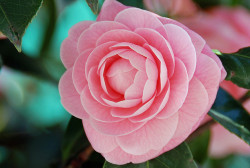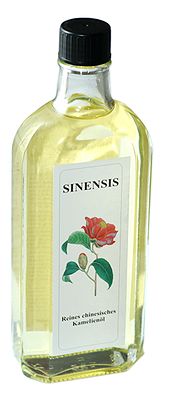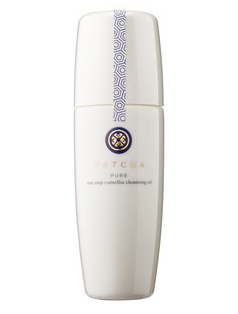While wistfully window shopping the aisles of Sephora recently, I eyed a pricey cleanser touting the latest buzzed-about beauty oil: Camellia oil. Now it’s so secret that we’re crazy for natural beauty oils around here, but even I’m starting to get beauty oil fatigue (that’s a thing, right?). It seems with each year there’s another newer, rarer, more miraculous oil on the scene, each claiming to do everything from cure acne to prevent cancer. So is camellia oil truly an ancient beauty secret, or just high priced hype? Here’s what I found:
Camellia oil is a pale greenish oil with a mild, herbal scent. Also known as tea seed oil (not to be confused with tea tree oil), it is cold pressed from the seeds of the Camellia sinensis plant, a flower which comes from China and Japan. Camellia oil is most commonly used today as a healthy cooking oil in places like China, but it also has a long history as a traditional beauty product. Supposedly, in Japan, geishas used camellia oil as a makeup remover and cleanser. It was also used to give that beautiful lacquer shine and sleekness to the elaborate up-dos of the geisha and samurai. It all sounds intriguing, but what does it actually do?
I was pleasantly surprised to find that camellia oil does, in fact, make a great multipurpose natural oil for both skin and hair. It contains vitamins A, B, D, and E, polyphenols, and omega-9 fatty acids. It contains more naturally occurring antioxidants than almost all other botanical oils. And because its essential fatty acids and lipids are similar to the proteins contained in the top layers of skin and hair, it easily absorbs without the greasy feeling. While it’s a great option for both face and body, it seems the most popular use of camellia oil is for hair. The oleic acids nourish, protect and condition the hair, giving it that shine that you get from silicone based products but without the sticky build up.
In a lot of ways, it sounds similar to my all-time favorite natural oil, jojoba oil. However, it also appears to be the pricier of the two. While I have used camellia oil, it was mixed in conjunction with a variety of other oils, so it’s hard to say whether it could steal the throne from my beloved jojoba.
Tatcha Camellia Cleansing Oil, $48 on Sephora is cruelty-free, and formulated without parabens, sulfates, or phthalates.
Readers, have you used camellia oil, and did you like it?
Related: Beauty Benefits of the Rose
DIY Luxurious Whipped Body Butter
Anti-Aging Benefits of Resveratrol
Should You Use a Retinol Cream?
Photo: naitokz via Flickr; Wikipedia







